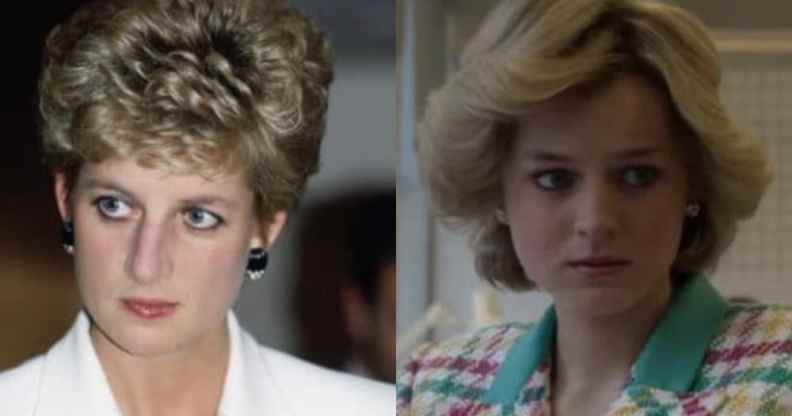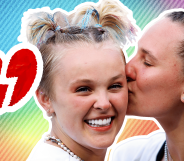This is what The Crown gets very right and very wrong about Princess Diana and the AIDS crisis

Princess Diana’s AIDS activism got a mention in the final episode of The Crown’s fourth season (Tim Graham/Getty)
Princess Diana's AIDS activism got a mention in the final episode of The Crown's fourth season (Tim Graham/Getty)
The Crown season four finally introduces Princess Diana and touches on her legacy of fighting HIV/AIDS stigma – with mixed results.
It’s hard to think of a decade with more lasting impact on the lives of queer people than the 1980s, from the passage of Section 28 by Margaret Thatcher to the AIDS crisis and demonization of queer people in public life.
The long-lingering trauma of the decade still looms large today, and the writers of The Crown had a steep challenge in attempting to depict the polar extremes of Thatcher and Princess Diana, the latter of whom is still remembered as one of the shining beacons of the community during the AIDS epidemic.
Years before another member of the royal family would be willing to public acknowledge either HIV or homosexuality, at the height of the pandemic Princess Diana paid defiant visits to HIV/AIDS clinics – both in front of and away from the cameras – helping to bust misplaced public misconceptions about the virus by holding hands with and hugging patients.
While Section 28 is skipped by The Crown entirely to the show’s clear detriment, the writers did manage to find time to address Diana’s work on AIDS in the very last episode of the season. Warning – spoilers follow.
What The Crown gets right and wrong about Princess Diana and the HIV/AIDS crisis
The final episode of The Crown season four depicts Princess Diana paying a visit to a Harlem hospital filled with young people suffering from AIDS while on a solo visit to New York, amid tensions in her marriage to Prince Charles.
Doctors introduce Diana to a young boy who is unable to find a foster carer “because of the stigma, the fear of the disease”, leading her to hug him in front of the cameras.
The Crown weaves together real events and the fictional, but the hospital scene really did happen, with Diana attracting attention in New York by hugging children on the visit to the AIDS unit in 1989 – a timeline slightly adjusted by the show, which sets the scene against Margaret Thatcher’s ousting from power in 1990.
It’s not just the timing that’s distorted for narrative reasons, either, with Diana’s apparent ignorance on the issue prior to the New York visit far removed from the truth of her work.
In reality, it was much earlier in the AIDS crisis, in 1987, when Diana opened the UK’s first purpose built HIV/AIDS unit in London, and first made headlines in front of the world’s media by holding hands with a young man suffering from the virus.

Diana, Princess of Wales shakes hands with an AIDS patient, an image that would come to symbolise her kindness and activism. (Anwar Hussein/WireImage)
Her work on the issue was also much more deliberate and determined than portrayed by the show, with the basic explanations about the virus likely more for the audience’s benefit than for Diana’s.
The princess made countless visits to AIDS patients over the years that followed, at a time when most politicians – including both Margaret Thatcher and US president Ronald Reagan – preferred to eschew all mention of the crisis due to its roots in the gay community.
The royal family were not happy about Princess Diana undertaking HIV and AIDS work.
The Crown also hints at the real-life adverse reaction to Diana’s visits from other members of the royal family.
In an angry confrontation in the wake of the visit, Prince Charles hits out at “the calculated vulgarity of the antics knowing full well the headlines they would get”, raging: “Grandstanding like that… you think we couldn’t do that too? Theatrically hug the wretched and the dispossessed and cover ourselves in glory on the front pages?”
The real-life reaction of Prince Charles to his wife’s work can only be speculated about, but he certainly did not take up her interest in HIV/AIDS at the time, and has not made significant contributions on the issue since.
However, multiple reports have indicated there was real royal anger on the issue stemming from further up the food chain, with the Queen said to have disapproved of Diana’s work and urged her to do “something more pleasant” with her time.
Speaking at Diana’s inquest in 2008, her former bodyguard and confidante Ken Wharfe said attempts to stop her work on the issue had left her “furious.”

Prince Charles was depicted flying into a rage with his wife after the trip, in a fictional scene (Netflix)
He said: “The princess would go to see the Queen on a number of occasions. Once, she returned and was distressed. I asked her: ‘What’s the matter?’ and she said: ‘The Queen doesn’t like me getting involved with AIDS and leprosy, [she told me] why don’t you get involved with something more pleasant?’
“Diana was angry the Queen could not see what she was doing. She felt a member of the royal family should be involved with campaigns to find a cure for AIDS.”
Speaking about her work at an AIDS conference in 1991, Diana said: “AIDS does not make people dangerous to know, so you can shake their hands and give them a hug. Heaven knows they need it. What’s more, you can share their homes, their workplaces, their playgrounds and toys. We all need to be alert to the special needs of those to whom AIDS is the last straw in an already-heavy burden of discrimination and misfortune.”
Diana’s sons keep her legacy alive.
Prior to his departure from his role as a working royal earlier this year, Diana’s younger son Prince Harry had taken up campaigning on the issue in his mother’s memory.
Speaking about her work in 2017, he reflected: “She felt a responsibility to shine her spotlight on the people and issues that were often ignored. She knew that AIDS was one of the things that many wanted to ignore and seemed like a hopeless challenge. She knew that the misunderstanding of this relatively new disease was creating a dangerous situation when mixed with homophobia.
“People were ostracized from their communities – and sometimes from their families – simply for being ill. Staff who treated the ill, were themselves often turned away from local barbers and restaurants, even though it was proven that HIV could not be passed on from casual contact.
“And we faced the very real risk that thousands would die in the UK – including many young gay men of her generation – without making any progress towards treatment of the disease.
“So when [in 1987], she shook the hand of a 32-year-old man with HIV, in front of the cameras, she knew exactly what she was doing. She was using her position as Princess of Wales – the most famous woman in the world – to challenge everyone to educate themselves; to find their compassion and to reach out to those who need help instead of pushing them away.”
Meanwhile, her elder son Prince William was the first ever member of the royal family to publicly talk about homosexuality, telling a group of kids to stand up to homophobia on a 2015 visit with Diana Award, the anti-bullying charity conceived in his mother’s memory.

